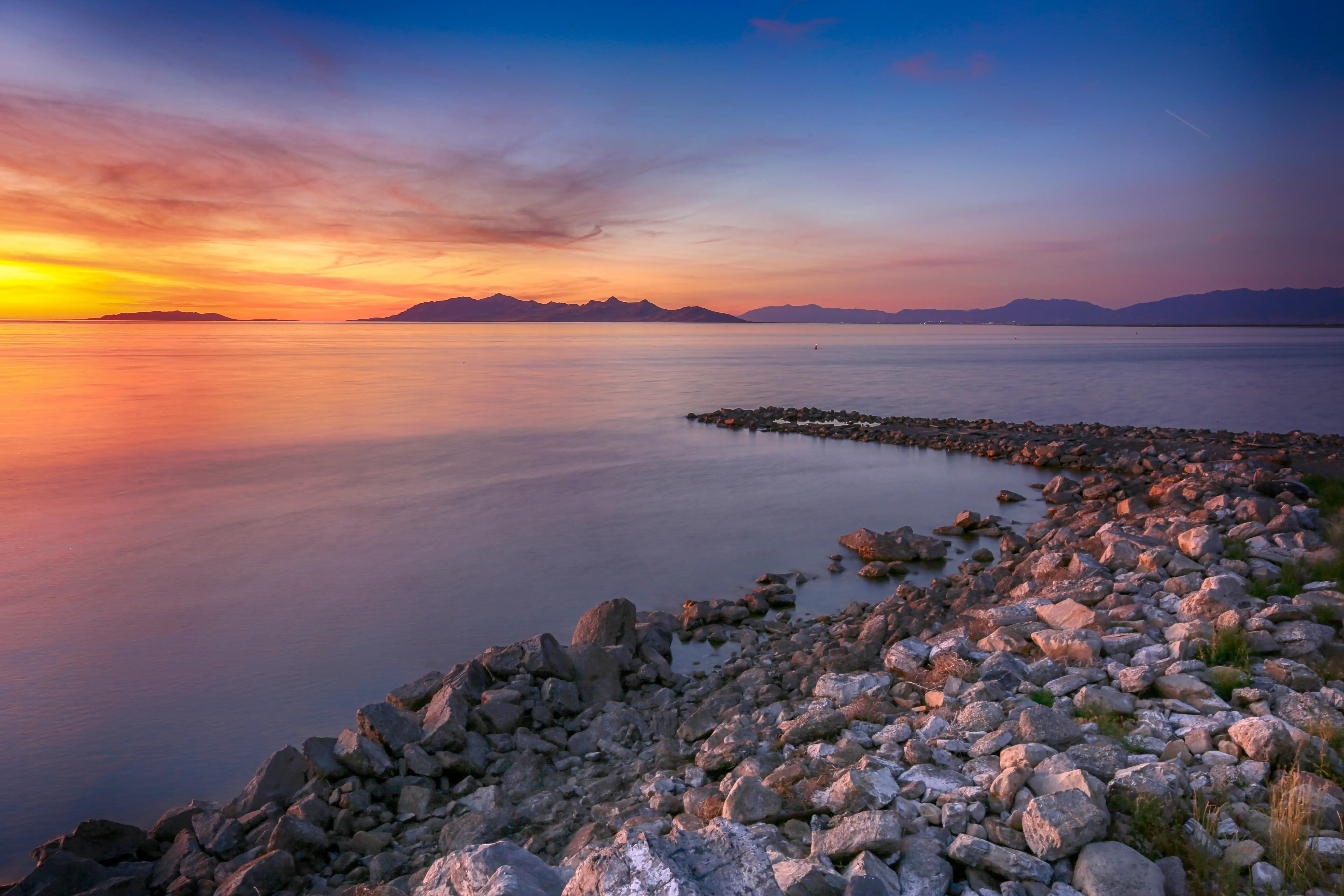Lakes & Rivers in Salt Lake City, UT

Explore lakes and rivers in Salt Lake City, UT, serene escapes and full of recreational opportunities within the urban area. The Great Salt Lake, a short drive northwest of downtown, is a globally unique landmark known for its high salinity, stunning sunsets, and abundant birdlife, making it a popular spot for kayaking, sailing, and bird-watching.
For those seeking a more natural setting, Little Dell Reservoir, located just 13 miles east in the foothills of the Wasatch Mountains, provides a peaceful retreat for fishing, kayaking, and enjoying the surrounding mountain scenery. These lakes, reservoirs, and creeks, bring a refreshing mix of nature and recreation to Salt Lake City’s vibrant urban landscape.
Great Salt Lake
The Great Salt Lake is an iconic natural feature of Utah, located just northwest of Salt Lake City. It is the largest saltwater lake in the Western Hemisphere and a remnant of ancient Lake Bonneville. Known for its high salinity, which allows visitors to float effortlessly in its waters, the lake is also a critical habitat for millions of migratory birds, with unique ecosystems supported by brine shrimp and algae. Popular activities around the lake include sailing, kayaking, and bird-watching, with access points like Antelope Island State Park, which offers hiking trails and beaches.
Little Dell Reservoir
Little Dell Reservoir is a tranquil getaway located just 13 miles east of downtown Salt Lake City. This 249-acre reservoir is surrounded by rolling hills and mountain vistas, offering a serene environment for fishing, kayaking, paddleboarding, and picnicking. There are target species like Bonneville cutthroat trout, though fishing restrictions apply to protect the area’s natural habitat. The reservoir does not permit motorized boats, ensuring a peaceful atmosphere for visitors.
Jordan River
The Jordan River flows for 51.4 miles, connecting Utah Lake to the Great Salt Lake and cutting directly through the Salt Lake Valley. In Salt Lake City, the river is accompanied by the Jordan River Parkway, a popular multi-use trail that provides opportunities for walking, cycling, and bird-watching. The river itself supports fishing for species like catfish and carp, and its calm waters make it ideal for kayaking and canoeing. Parks along its banks, such as Jordan Park and the International Peace Gardens, offer scenic spots for relaxation.
City Creek
City Creek originates in the Wasatch Mountains and flows through the picturesque City Creek Canyon, eventually reaching downtown Salt Lake City. The creek provides a peaceful natural retreat, with hiking and cycling trails that wind alongside its waters. Wildlife like deer and birds are commonly seen here.
Red Butte Creek
Flowing from Red Butte Canyon through the University of Utah campus and surrounding neighborhoods, Red Butte Creek contributes to irrigation and enhances the greenery of the city. The creek runs near Red Butte Garden and Arboretum, and its cool, shaded banks are also home to native plant species and small wildlife, offering a glimpse of the local ecosystem.
Emigration Creek
Emigration Creek begins in Emigration Canyon, a historic route used by Mormon pioneers. As it meanders through residential neighborhoods and parks. It eventually joins the Jordan River, playing a critical role in the city's watershed. Its serene flow and historical significance make it a cherished waterway in the area.
Parley’s Creek
Starting in Parley’s Canyon, Parley’s Creek flows through popular spots like Sugar House Park before merging with the Jordan River. The creek is known for its scenic, tree-lined banks. Sugar House Park, in particular, is a favorite for families, with trails that allow visitors to enjoy the creek’s beauty up close.
Mill Creek
Mill Creek originates in Mill Creek Canyon and flows through southeastern Salt Lake City, offering both natural beauty and recreational opportunities. The creek supports a variety of wildlife and is often accompanied by trails for hiking and cycling.
Big Cottonwood Creek
Flowing from the Wasatch Mountains through Big Cottonwood Canyon, the creek's crystal-clear waters and lush surroundings make it a popular spot for fly fishing, with species like trout frequently found in its waters. Scenic trails along the creek offer hiking opportunities with stunning views of the canyon.
Little Cottonwood Creek
Starting high in the Wasatch Mountains, Little Cottonwood Creek winds its way through Little Cottonwood Canyon, known for its dramatic cliffs and alpine scenery. The creek contributes to the local watershed and serves as a serene backdrop for outdoor activities like picnicking, hiking, and wildlife watching.